Selfadvocatenet.com Has just learned that Canadian govt has released the details of findings of the
New National Accessibility Legislation
 Carla Qualtrough Minister of Sport and Persons with Disabilities.
Carla Qualtrough Minister of Sport and Persons with Disabilities.
Has announced
Official title: Accessible Canada – Creating new national accessibility legislation:
What we learned from Canadians
On this page
- Message from the Minister
- Why Canada needs accessibility legislation
- Our discussion with Canadians
- What we mean by accessibility and disability
- Consulting directly with individuals
- Ideas and key findings
- Areas of focus moving forward
- Ensuring the new legislation is working
- Changing the culture
- Conclusion
Alternate formats

Creating new national accessibility legislation[PDF – 1.38 MB]
Message from the Minister
May 29,2017
As Canada’s first-ever Minister responsible for persons with disabilities, I had the honour of leading Canada’s largest and most accessible consultation on disability issues ever.
In the summer of 2016, I began asking Canadians all across the country, “What does an accessible Canada mean to you?” What we learned, summarized in this report, will help us create new federal accessibility legislation.
I’m proud to say more than 6,000 Canadians participated in person and online. Throughout the consultation, I held 18 in-person public meetings across the country that were supported by local leaders from the disability community. These meetings were made fully accessible for a range of disabilities and included English and French real-time captioning, American Sign Language and Langue des signes québécoise, and intervenor services for participants who are deaf-blind. In northern Canada, Inuit sign language was also provided.
The online consultation set equally high standards of accessibility. Consultation questions were available in Braille, large print, e-text, audio and sign language. Participants were also invited to share their ideas by email, phone or TTY or by sending audio or video recordings.
I also worked hand-in-hand with disability organizations and national Indigenous organizations across Canada to ensure that everyone who wanted to participate had the opportunity to do so.
Through the consultations, Canadians from across our country shared their personal stories—their challenges, successes, hopes and aspirations. I heard from youth who wanted equal access to education, I heard from parents with dreams of their children being self-sufficient and I heard from young adults frustrated with their ability to access public services. Yet there was one common theme: They each faced a barrier that limited their ability to be fully included.
I recognize that new federal legislation will not address every barrier that Canadians with disabilities face. In fact, many issues raised were beyond the reach of federal jurisdiction. I do, however, share the same hope and optimism of the thousands of those who participated on how the Government of Canada can be a leader with this new legislation and how this new legislation can bring about real change for Canadians with disabilities.
Moving forward, we’re going to take what we learned through this historic consultation process to develop new federal accessibility legislation that will provide all Canadians a better chance to succeed in their local communities and workplaces. We will also share what we learned with all levels of government and encourage them to join us in our journey to make a more accessible Canada.
This consultation process was a very important step forward towards inclusion, but it is only the beginning of a journey to reach our goal of a truly inclusive Canada. Thank you to all who participated.
Together, we are making history.
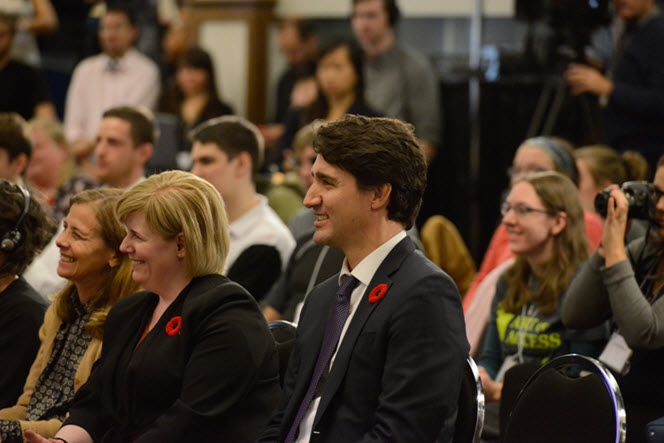
Why Canada needs accessibility legislation
“We need people to dream about a better world. How this government responds to your views about what’s important—not just over the next couple of years, or the next election cycle, but for the next decade and generation—will help us remain focused on what really matters.”
– Prime Minister Justin Trudeau, Accessible Canada National Youth Forum
“When we talk about an accessible Canada, what we’re really talking about is creating an inclusive society where all Canadians have an equal opportunity to succeed, and are equal participants. Together, we can make it happen.”
– The Honourable Carla Qualtrough, Minister of Sport and Persons with Disabilities
As Canadians, we all benefit from accessibility when we and our family members, friends, neighbours, classmates and co-workers are able to fully participate and contribute in our communities and workplaces without barriers. These barriers, however, continue to exist today and limit the social, political and economic inclusion of persons with disabilities across Canada.
Examples of these barriers include:
- negative attitudes or beliefs about what a person with a disability can or cannot do;
- buildings and spaces that cannot be accessed or are not easy to navigate;
- information that is difficult or impossible to access, read or understand either due to technology or the way it is presented;
- computers, equipment and web applications that are difficult or impossible to use; and
- rules and practices that leave individuals out.
Currently, one in seven Canadians has a disability, and that number is expected to grow with an aging population. It is clear that these barriers to accessibility can no longer be ignored. This is why the Government of Canada is working towards new legislation to help address these barriers and strive towards a more accessible Canada.
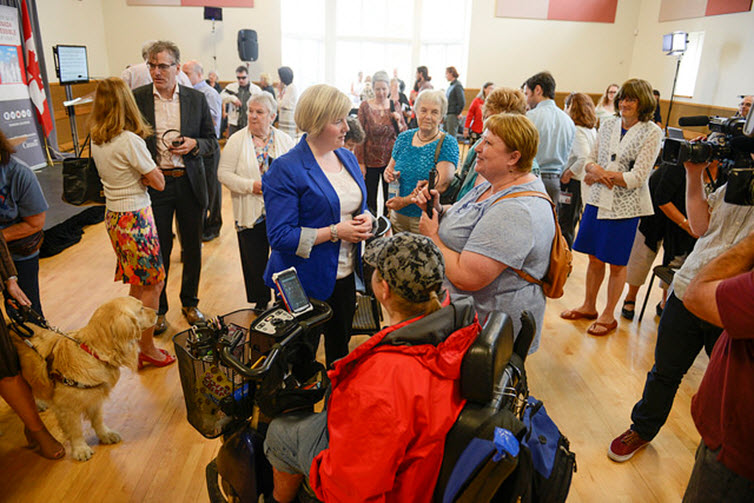
Our discussion with Canadians
In November 2015, Prime Minister Justin Trudeau asked Minister Carla Qualtrough to engage Canadians directly about what is needed in new legislation that would help remove barriers and prevent new barriers from being created for persons with disabilities.
In June 2016, Minister Qualtrough began her discussion with Canadians by launching a new website, Accessible Canada, where she asked all Canadians to think about what accessibility means to them and what it could mean for their communities. Between June 2016 and February 2017, over 6,000 Canadians and over 90 organizations shared their ideas about an accessible Canada, marking the largest and most accessible consultation on disability issues that Canada has ever seen.
The consultations reflected the spirit and hope that Canadians have toward the proposed legislation and strove to honour the disability community’s principle of “nothing about us without us.” Canadians were encouraged to share their ideas and were offered many different opportunities to do so.
- Over 4,300 people answered questions online and over 200 people shared their ideas via letters, emails, videos or phone.
- Over 90 reports were provided by disability organizations, unions, businesses and other levels of government.
- Over 1,400 people participated in 18 meetings held across Canada.
- One hundred and fifteen youth from across the country attended a one-day Youth Forum hosted by the Minister. These young leaders with disabilities worked together to share their ideas. The Prime Minister also attended and hosted a question and answer period with participants.
- Over 110 experts attended thematic roundtables hosted by the Minister on disability issues. At these meetings, specific accessibility topics were discussed such as how to make public spaces, transport and customer service more accessible.
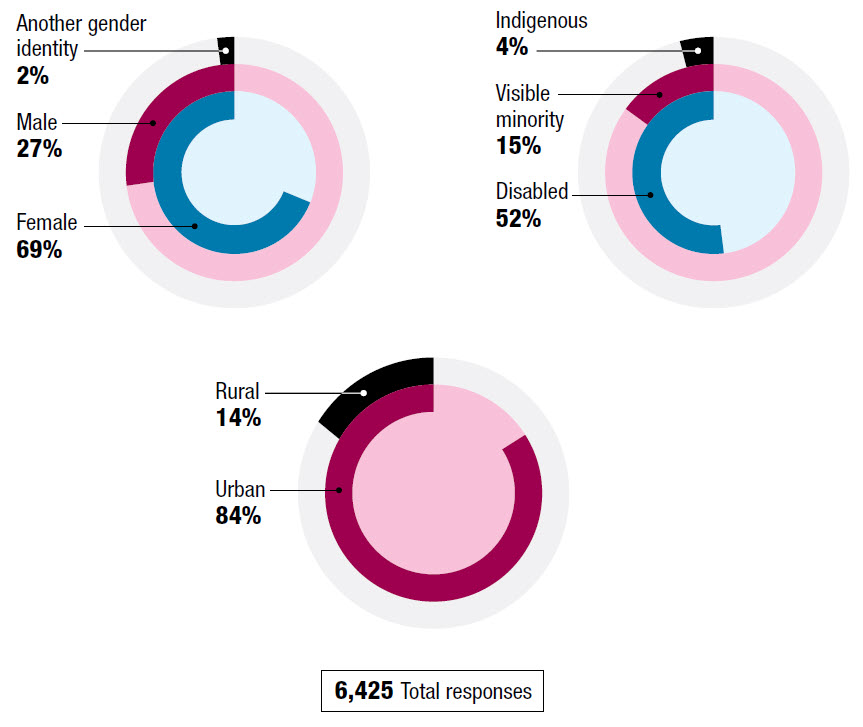
The three pie-charts in Graph 1 show who participated in the online consultation.
- Gender: Female (69%), male (27%), another gender identity (2%).
- Rural (14%) / Urban (84%) /
- Disabled (52%) / Visible Minority (15%), Indigenous (4%).
- 6425 People responded to the online consultation.
“Normally, when I go to events, I need to worry about whether I can participate, enter the room, have space for my scooter or sit at the table. I have to call in advance and make back-up plans and my own arrangements. With these consultations, I didn’t have to question or worry. They were accessible and I felt welcome.”
– Anonymous, Ottawa
“This consultation was the first time in more than 20 years that I was able to use my language of choice, Langue des signes quebecoise, to communicate with my government.”
– Anonymous, Whitehorse
Throughout the consultations the Government of Canada asked a number of important questions, including:
- What should be the goal of the new legislation?
- What accessibility barriers should be included?
- How do we make sure the new legislation is being followed?
- In addition to the new legislation, how should we better promote accessibility?
- How do we ensure that all Canadians are informed on a regular basis if the new legislation is working, or if it needs to be improved?
For nine months, we listened. For nine months, Canadians shared their ideas and their experiences about what concerns them. For nine months, we heard what makes them hopeful and what they think we, as a country, need to do to create an accessible Canada.
This is what we learned.
What we mean by accessibility and disability
“Accessibility is the complete ability to join in, participate or attend the activity or conversation as much as anybody else of my age in my community.”
– Anonymous
Participants expressed the importance of how the Government of Canada uses “disability” and “accessibility” broadly in the legislation so that everyone with a disability is included. They indicated that the meaning of “disability” should include a full range of abilities and limitations, including “invisible” disabilities, such as learning disabilities or mental health issues, and episodic disabilities, such as multiple sclerosis or epilepsy.
Participants also indicated that anything that prevents or limits persons with disabilities from being fully included, or able to do the same activities as persons without disabilities, should be considered a “barrier.” This would include barriers that are physical, such as an inaccessible washroom, and barriers that are not, such as a hiring practice that intentionally or unintentionally limits access to employment.
“My definition of ‘barrier’ is anything that impairs or prevents access, physically or mentally, to any physical movement, learning and/or acceptance by others. Ergo, ‘accessibility’ successfully counters or eliminates the barriers.”
– Pat Almond, Alberta
Consulting directly with individuals
During the consultations, participants said that for generations Canadians with disabilities have been excluded from many areas of daily life. One of the most significant areas of exclusion has been around personal decision making. This includes being given the opportunity to have a choice regarding personal matters such as where to live, what medical procedures to have, how to save and spend money, whom to marry and whether or not to have children. Canadians with disabilities have also been excluded from government programs, policies and laws that impact their lives.
Participants were hopeful that new accessibility legislation will address these concerns of exclusion and ensure their future participation in government decision making. They shared a variety of ideas on how this could be done, such as:
- participating on advisory committees;
- attending public meetings;
- completing online consultations; and
- providing feedback to people and organizations about their experiences.
It was made clear: Canadians with disabilities must be consulted from the outset, and that this consultation must be done directly, regularly and meaningfully, not only in the development of Government of Canada priorities, services and policies, but also in making sure the new legislation is successful. Canadians with disabilities never again want to be excluded from decisions that impact their lives.
“Input from all stakeholders (for example, persons with disabilities, caregivers, allies, family members, etc.) should be required and happening! As we often say in the Disability Action Hall, ‘Nothing About Us Without Us’ please.”
– Anonymous
While some participants indicated they were First Nation, Inuit or Metis, many participants said that we needed to have more conversations with Indigenous Canadians. The Government of Canada recognizes the need to continue this conversation regarding the barriers faced by Indigenous Canadians and their ideas on how to improve accessibility.
Ideas and key findings
Whether online, by mail or in meetings, participants showed hope and excitement for new accessibility legislation that would improve the quality of life for Canadians with disabilities.
While there was agreement on many overarching ideas, there were often different opinions about how the new legislation could work. For example, some ideas that were shared reached beyond the responsibility of the Government of Canada and its new accessibility legislation. These ideas were for cities, communities, organizations and business that mostly fall within provincial or territorial laws.
Participants also discussed areas where the federal, provincial and territorial governments share some responsibilities. For example, participants discussed how accessibility interacts with issues of poverty, housing, education and health care. These ideas spoke to the demand for an “all of Canada” approach to accessibility. It was committed that what was learned from the consultation will be shared across all levels of government.
Participants shared many personal stories about barriers they face and about how often these barriers are made worse by a lack of understanding or the lack of availability of services. They also shared stories about facing the same barriers again and again and having to find their own solutions. Many participants noted that they are tired of having to struggle to have barriers removed and frustrated that barriers often stop them from fully participating. Alternatively, some participants noted a strong feeling of being included in their communities and shared stories about the important roles of family, friends and neighbours.
Every participant was clear: It is not acceptable for Canadians with disabilities to be excluded from any aspect of life. Regardless of age, gender or where they live, we learned that participants share many similar ideas about what an accessible Canada means to them and how to achieve it.
Key messages heard
Here are some of the important messages we heard:
The new legislation should be ambitious and bold:
- Accessibility is a human right and should apply to all areas of daily life.
- New legislation should take a principled approach recognizing full citizenship, and helping Canada achieve its obligations under the UN Convention on the Rights of Persons with Disabilities.
- New legislation and complementary programing should be properly resourced to support the goal of a truly accessible Canada.
The new legislation should lead to more consistent experiences of accessibility across Canada:
- Participants want to see all levels of government work together to improve accessibility in all areas.
- New legislation should lead to the development of accessibility standards that other governments in Canada could adopt.
- New legislation should build on existing standards that are already working well.
“The key to success would be to engage provincial and municipal governments and have the legislation adopted as a practicing standard, similar to building codes. Rather than developing their own, other levels of government can simply state that they are adopting the national legislation as their basis. It doesn’t help a disabled person to know they can get around in a federal building if they encounter numerous barriers on their way there.”
– Anonymous
The new legislation should apply to all areas under the control of the Government of Canada, including:
- buses, ferries or air travel across provincial and international borders;
- the broadcasting and telecommunications sectors;
- the banking and financial sectors;
- federal lands, including parks and First Nation reserves; and
- the Government of Canada as a law- and policy-maker, employer, service provider, builder and buyer.
The Government of Canada should be a leader in accessibility by:
- hiring and supporting employees with disabilities;
- ensuring that all Government of Canada services and programs are accessible;
- using only buildings and public spaces that are accessible and that persons with disabilities can access;
- ensuring that the goods and services purchased by the Government of Canada can be used by persons with disabilities; and
- establishing a process where all Government of Canada laws and policies are reviewed, taking into consideration persons with disabilities.
No organization should be excluded from the new legislation
- No organization should be excluded from having to follow the new accessibility legislation.
- Participants did note that accessibility regulations may need to be different for some groups or organizations. For instance, there may need to be slightly different rules for organizations like airlines or banks due to international standards and/or other extenuating circumstances.
- Participants did recognize that the development and implementation of some standards will take longer than others.
“We need all organizations to be covered by this legislation. It is no longer reasonable to allow several levels of government to decide what Canadians need. Accessibility must become a federally regulated legislation to ensure that all Canadians have the same right to access under the law. The current approach is too piecemeal.”
– Gail Paton, Ontario
There was no consensus on a single area of accessibility being more important than another
- Most participants saw all types of accessibility as interconnected and equally important.
- Among those who identified a priority, employment and job retention were the most important issues.
Participants are not only eager to help develop the new legislation, but they also want to help implement and make sure people follow the legislation:
- There was consensus that new legislation should not only be strongly enforced but also contain penalties.
- Most participants also saw the legislation as an opportunity to empower persons with disabilities with new leadership roles.
“The federal government needs to put some ‘teeth’ into disability legislation, to police provincial and municipal compliance with regulations, and should also provide paid advocates to help the disabled ensure that their voices are heard.”
– Anonymous
We must change how people think about accessibility and Canadians with disabilities if we are to secure a lasting and positive change
- Changing how people think about accessibility and fellow Canadians with disabilities is vital to achieving lasting improvements.
- Employers and children/youth were frequently identified as priority groups to engage in order to change existing attitudes.
Beyond these key messages heard, participants, experts and community partners shared their views on specific areas in which the legislation could affect change, how to ensure the legislation is followed, and how to change the culture of how persons with disabilities are perceived. These topics are explored in more depth in the following sections.
Areas of focus moving forward
All areas of life are connected and need to be made accessible if people are to be fully included. However, when participants were asked to choose one area of accessibility for the Government of Canada to focus on, the top six priorities were:
- employment;
- access to buildings and other public spaces through a built environment;
- transportation by air, train, ferry and buses;
- program and service delivery;
- information and communications; and
- procurement of goods and services.
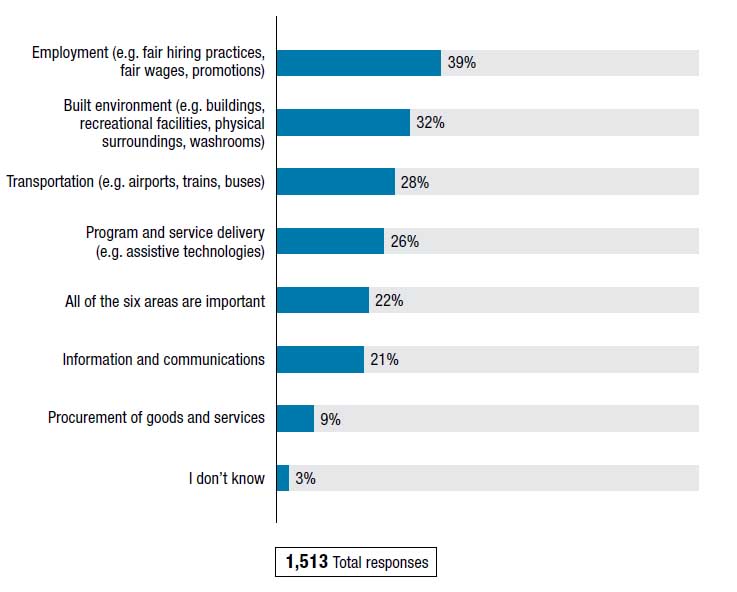
Graph 2 shows the results to the question: “Which areas are the most important for improving accessibility?”
- Thirty-nine percent say that employment (for example, fair hiring practices) is the most important, followed by built environments (32%), transportation (28%) and program and service delivery (26%). All of the six areas are important (22%), information and communications (21%), procurement of goods and services (9%) and I don’t know (3%).
- 1,513 people responded to this question
The following provides more detail regarding what was heard and how the Government of Canada can improve accessibility in these six key areas:
Access and transition to employment
Participants talked about the importance of workplaces that address barriers and allow persons with disabilities to obtain a first job, succeed in their work and get promoted as leaders. Participants also emphasized that employers need to understand that workplace adjustments can often be a smart investment that helps all employees, and their business or organization, succeed.
Existing requirements for employers to make their workplaces more accessible were noted to be positive (for example, Employment Equity Act and the Ontario Employment Standards). However, participants and stakeholders emphasized that more needs to be done. For example, there could be more detailed requirements to ensure that recruiting and hiring processes are accessible. Further, new requirements could be made to support an employee’s return to work if they acquire a disability while employed.
We also heard that more could be done to make sure that workplace policies do not result in more barriers to accessibility including making sure employers understand the value that employees with disabilities can bring to the workplace.
There was also strong recognition that employers need to be better supported in this area.
“There are thousands of persons with disabilities who also have university degrees. Yet, it is very difficult to get hired by any employer, including the federal government.”
– Anonymous
Access to buildings and public spaces
When people think about accessible buildings, they often only think about physical disabilities and the need for ramps, elevators and accessible washrooms.
Participants made it clear that all disabilities need to be considered when looking at the accessibility of buildings and public spaces. This includes other impairments or limitations, such as those related to vision, hearing or intellectual disabilities. This broader recognition of how persons with varying impairments or limitations interact with their built surroundings was seen as a key consideration in moving towards “universal design.”
It was agreed that new buildings and spaces must be made accessible from the start while also working to make older buildings and spaces more accessible.
When discussing current building standards, participants shared concerns that the current building codes are only minimum requirements and that even these are not always being met. There was discussion on whether the Government of Canada should try to improve existing building codes or try to push builders to go beyond the minimum requirements with a program that recognizes builders who exceed them.
Participants also emphasized that government funding towards infrastructure projects should only be spent on projects that will be accessible.
Access to travel by air, train, ferry and buses
Transportation is an important part of all Canadians’ daily lives. It is how we get to work, go to a doctor’s appointment, go to a shopping centre, go on a vacation and visit family and friends. Without access to transportation, Canadians can become isolated and made more vulnerable.
The Government of Canada is responsible for travel by airplane, rail and some bus and ferry services between provinces and territories and internationally. Most other travel within a city or a province, whether by bus, streetcar or train, is the responsibility of other levels of government. As previously mentioned, the Government of Canada will share this feedback with other levels of government.
Participants noted that they want the legislation to ensure that every part of their journey is made more accessible. This includes all steps between leaving home and arriving at a final destination.
Participants also noted that existing standards for transportation could be made more clear and responsive to the needs of persons with disabilities.
Finally, participants talked about how the Canadian Transportation Agency, the organization responsible for transportation standards, could be given more authority in certain areas, such as looking into issues proactively.
Customer service
Many participants conveyed that Canadians with disabilities do not always receive an equal quality of service. For example, Canadians with disabilities often encounter barriers at service counters, when talking to customer service personnel over the telephone or when communicating with organizations online.
Participants discussed how Canadians with disabilities have challenges communicating with customer service staff and often receive documents in formats that are not accessible. Specifically, participants said there is often a lack of sign language interpretation, and that persons who have difficulty speaking or who use a communication device are often not understood.
Participants also said customer service staff do not always understand how to serve Canadians with different types of disabilities. It often becomes the responsibility of the person with a disability to propose a solution.
When facing customer service issues, Canadians with disabilities are often offered alternative options of lower quality. Canadians with disabilities, however, want to be offered real choices and to have the opportunity to decide how services are provided to them. It is clear that they want opportunities to let businesses and organizations know when they have service issues and where improvements can be made.
Accessibility of computers, smart phones and other technology
Participants discussed the importance of information and communication technologies in their daily lives. Many agreed that the Government of Canada should use standards for information and communication technologies for all digital content, such as the Web Content Accessibility Guidelines.
Telecommunications and broadcasting, and the way all businesses use these products and services, are always changing. Canadians with disabilities are concerned that both devices and content will not be accessible for their needs. Most participants recommended that the Canadian Radio-television and Telecommunications Commission be given additional powers to ensure that the accessibility of telecommunications and broadcasting products and services continues to improve over time.
“Why can I only check-in for a flight using the desktop version of a website? Why aren’t mobile versions and apps accessible and either zoomable or useable by my screen reader?”
– Anonymous, Vancouver
Businesses talked about the challenges of making some products and services accessible when technology changes so quickly. They also raised the fact that much of the technology used in Canada is made outside of Canada.
Businesses want to know how accessible their products and services are, but they made it clear that any new standards should work with existing laws. They pointed out that new standards for accessibility can encourage businesses to make their products and services better. If standards are too restrictive, however, it can make it difficult for businesses to innovate.
Purchasing goods and services that are accessible to everyone
Participants want the new legislation to ensure that the Government of Canada only purchases goods and services that can be used by persons with disabilities.
Although the Government of Canada may have to invest more money upfront to ensure goods and services are accessible from the beginning, this is less expensive than addressing any accessibility costs after goods or services have already been purchased. Participants thought that the purchase of computers and technology is an area where government spending creates some of the biggest barriers for persons with disabilities.
The standards used by the European Union and the United States for buying computers, phones and other technology were pointed out as good examples for the new legislation.
Ensuring the new legislation is working
There was broad agreement amongst participants that the Government of Canada should be able to monitor how well the legislation is working and make changes to improve the legislation, if needed. Many expressed frustration that current laws are not reviewed frequently enough to improve accessibility.
Monitoring the progress of organizations in following the new legislation
Participants were asked about the ways the Government of Canada could monitor organizations to make sure they are following the new legislation. Most thought that a range of tools should be used and that Canadians with disabilities should be involved in the monitoring process. These tools included:
- Action plans – The legislation could require organizations to make action plans that describe how they will improve their accessibility over time.
- Progress reports – The legislation could require organizations to report on what they are doing to improve accessibility.
- Reviews – The legislation could describe how the Government would check the action plans and reports that organizations provide.
- Complaints – The legislation could describe how Canadians could make complaints if they think that an organization is not following the legislation.
Participants also recommended that the process to notify the Government of Canada when the legislation is not being followed should be simple and anonymous, if anonymity is desired.
“The complaint mechanism needs to be very clear and very accessible to allow the most vulnerable members of our community to still access it without trouble.”
– Anonymous
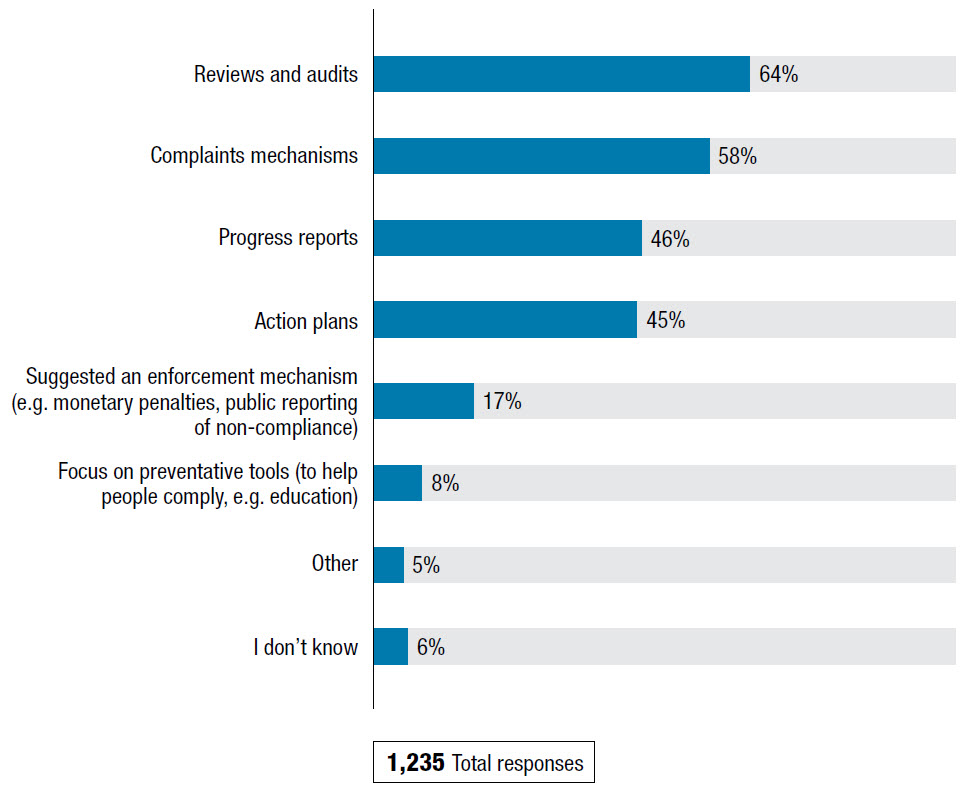
Graph 3 shows the results to the question: “What monitoring mechanisms do you think should be considered for the law?”
- Sixty-four percent say reviews and audits, followed by complaints mechanisms (58%), progress reports (46%), action plans (45%), suggested an enforcement mechanism (for example, monetary penalties, public reporting) (17%), and focus on preventative tools (to help people comply, for example, education) (8%). Five percent responded other and 6% responded I don’t know.
- 1,235 people responded to this question.
To oversee and respond to individual complaints, participants communicated a desire for the Government of Canada to create a new government or non-government body that could act independently to ensure organizations are following the legislation. For example, people could make a complaint to or ask for help from a commission or “ombudsperson” when they identify that the new legislation is not being followed. This new body could then investigate the complaint to make sure the legislation is being following by individuals, organizations and the Government of Canada.
“There should be one federal agency for all federal accessibility standards and enforcement, the new Canada Accessibility Commissioner.”
– Barrier Free Canada
Supporting organizations that follow the legislation, penalizing those that do not
Participants shared that not enough has been done to make sure current laws are followed. It was emphasized that existing laws rely too much on persons with disabilities to make complaints, placing the responsibility on the individual.
Overall, participants want the new legislation to “have teeth” and require organizations to make real improvements for Canadians with disabilities.
There was strong support for using a range of tools to make sure new legislation is followed, including:
- Recognition and incentives – Organizations and individuals should be recognized or rewarded for their efforts when they succeed in improving access for persons with disabilities.
- Mediation processes – When an organization faces issues following the legislation, persons with disabilities and representatives from the organization and the Government of Canada could meet to find a solution.
- Penalties – If organizations are not following the legislation or making an effort to address issues, there should be fines and penalties.
Many participants supported the idea of making each organization publicly report on how well it is following the legislation. They saw this as a way to reward organizations that are doing really well and motivate those that can do better.
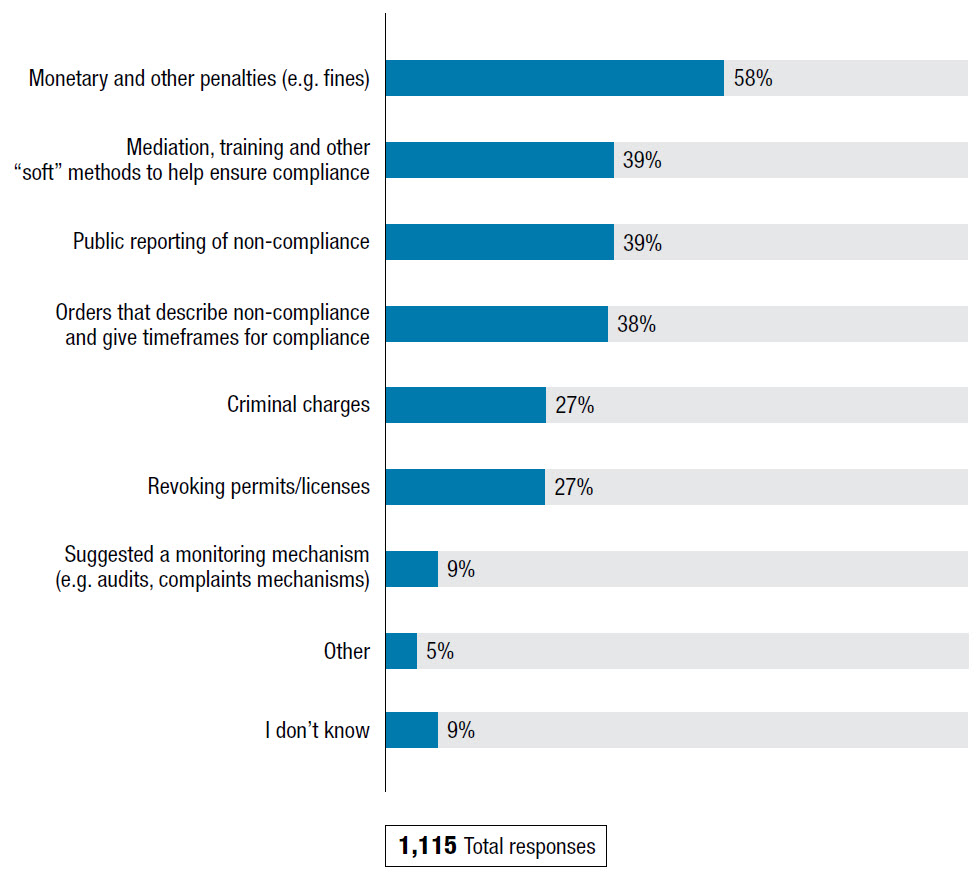
Graph 4 shows the results to the question: “What enforcement mechanisms do you think should be considered for the legislation (including ones not listed here)?”
- Fifty-eight percent say monetary and other penalties (for example, fines) followed by mediation, training and other “soft” methods to help ensure compliance and public reporting of non-compliance (39%, respectively), orders that describe non-compliance (38%), criminal charges (27%) and revoking permits/licences (27%). Nine percent suggested another monitoring mechanism. Five percent responded other and 9% responded I don’t know.
- 1,115 people responded to this question.
“I think it would be realistic to have a phase-in period for organizations to become compliant once the Bill is passed as law, and a gradual escalation process for organizations that are cited for non-compliance; beginning with informal mediation with a time period to become compliant, if the organization fails to conform to regulations after the set time period (without a reasonable rationale) then have their organization information posted/reported publicly with formal mediation and an order detailing areas of non-compliance with a secondary deadline to remedy the identified problems. If no actions are taken (without a reasonable rationale) to comply with the regulations, then penalties could be leveraged (whether they are in the form of fines, revocation of Charitable Status, etc…).”
– Alena Wickware, Ontario
“Financial support for actual removal of barriers—such as changing physical environment or training programs for staff for attitudinal barriers.”
– Djenana Jalovcic, Ontario
Making sure the legislation is improving accessibility
Overall, participants recommended that the Government of Canada should regularly report to Canadians how well the legislation is working and what needs to be improved. They want this work to be done by experts, Canadians with disabilities and disability stakeholders. The results should be made public.
Participants also told us that reporting should take place regularly, possibly on an annual basis. Some participants noted that reporting could happen more often during the first years of the legislation, and less frequently after it has been in place for several years.
Participants also shared their ideas about what should be included in the Government of Canada report. For example, the report could:
- look at how the legislation is improving the lives of Canadians with disabilities;
- report on which organizations are following the legislation;
- report on complaints about the legislation and what actions the Government of Canada has taken to make sure organizations follow the legislation; and
- compare how Canada is doing on accessibility to other countries.
“It should be comprehensive but focus on the outcomes and results. Should also be easy to understand.”
– Anonymous
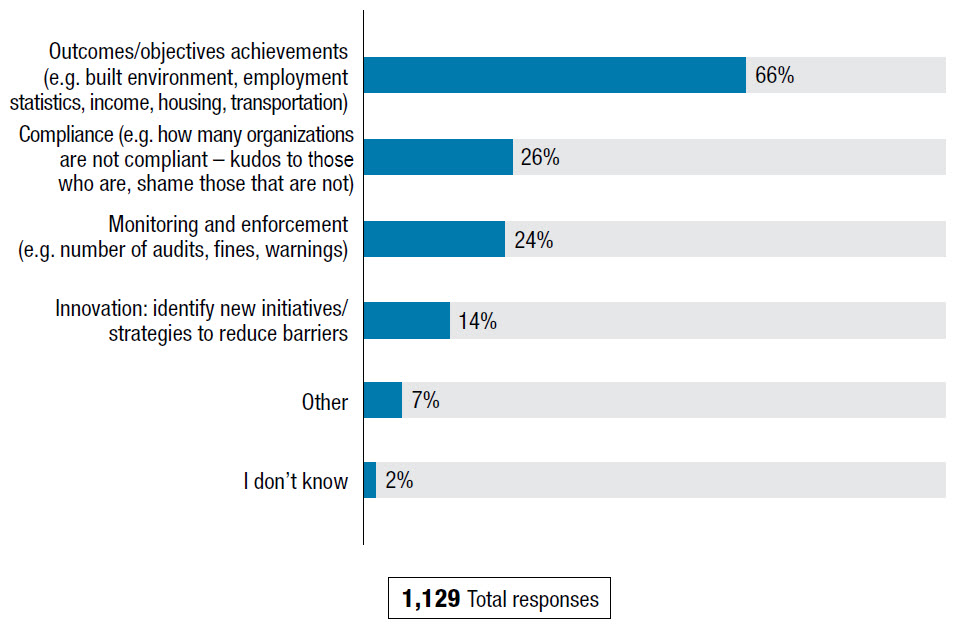
Graph 5 shows the results to the question: “What kinds of things should this report look at?”
- Sixty-six percent said outcomes/objectives achievements (for example, built environment, employment statistics, income, housing, transportation), followed by compliance (for example, how many organizations are not compliant, kudos to those that are, shame those that are not) (26%), monitoring and enforcement (for example, number of audits, fines, warnings) (24%) and innovation: identify new initiatives/strategies to reduce barriers (14%). Seven percent responded other and 2% responded I don’t know.
- 1,129 people responded to this question.
Changing the culture
Often, Canadians are not aware of the barriers faced by persons with disabilities. In order to change the existing culture, everyone needs to contribute in some way to make Canada more accessible.
Suggestions made by participants on how to change the way Canadians think about persons with disabilities were wide-ranging. The overarching theme was that a variety of tools should be used to change the way we talk about disability—change the language, shift the conversation and talk about full citizenship and inclusion.
Ideas included raising awareness through media campaigns, leveraging key leaders to change how Canadians talk about disability and educating young Canadians with a new way of thinking around accessibility and persons with disabilities. Participants also emphasized that businesses and organizations need to be better informed in hiring, employing and serving persons with disabilities.
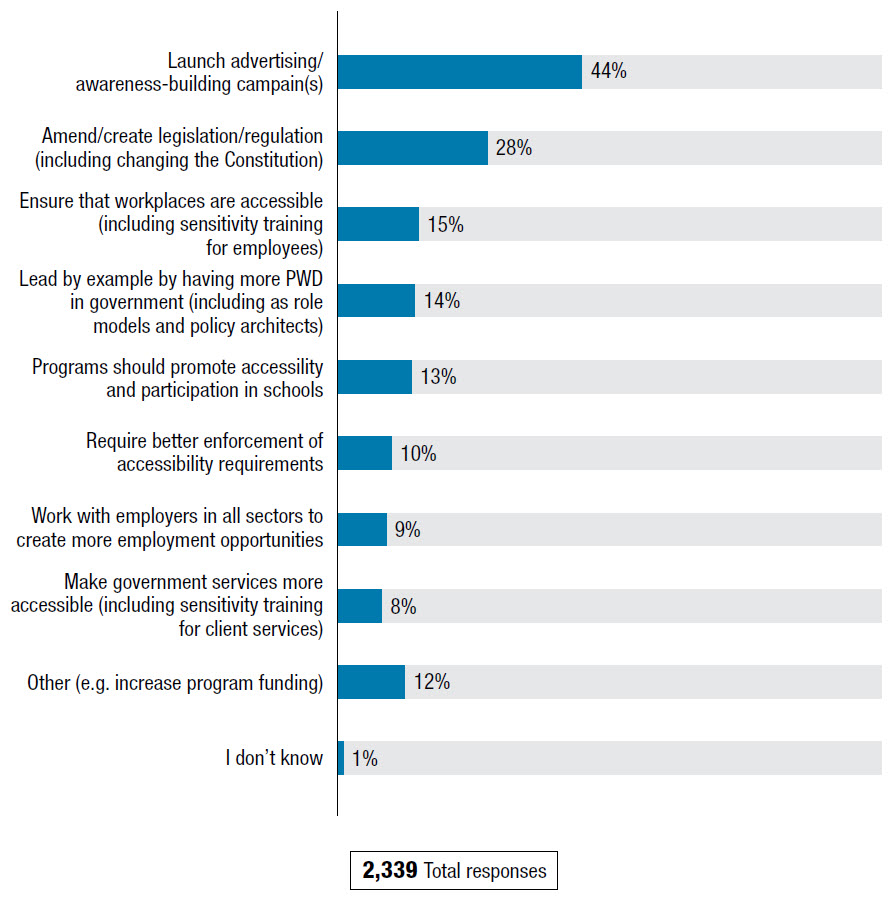
Graph 6 shows the results to the question: “How can the Government of Canada raise awareness of and change attitudes in relation to accessibility (in the short term and long term)?”
- Forth-four percent said “launch advertising/awareness building campaign(s), followed by amend/create legislation/regulation (including changing the constitution) (28%), ensure that workplaces are accessible (including sensitivity training for employees) (15%), lead by example by having more PWD in government (including as role models and policy architects) (14%), programs should promote accessibility and participation in schools (13%), require better enforcement of accessibility requirements (10%), work with employers in all sectors to create more employment opportunities (9%), and make government services more accessible (including sensitivity training for client services (8%).
- Twelve percent responded other (for example, increase program funding) and 1% responded I don’t know.
- 2,339 people responded to this question
“The long-term goal is to create conversations in elementary schools to shift attitudes about persons with disabilities in the workforce. Children will grow up informed and accepting of persons with disabilities.”
– Anonymous
Participants and businesses shared the belief that focusing on attitudes about persons with disabilities in the workplace is very important. They also shared the concern that businesses and organizations need to be supported on how to best support persons with disabilities in their workplaces. Sometimes, all that is needed is a small change which can help a person with a disability find or keep a job. Participants thought that it would also help to celebrate or recognize businesses and organizations that are doing a great job at hiring and supporting workers with disabilities.
Participants often told us that many businesses or organizations want to improve the workplace environment for persons with disabilities but don’t know how.
Participants recommended that the Government of Canada support the creation of an organization that provides technical assistance on how to improve accessibility. Examples of technical assistance provided could include helping businesses build an accessible recruiting and hiring process, and providing businesses advice on how they can meet and exceed existing workplace and employment standards.
Participants also suggested that the Government of Canada could help businesses and organizations pay for changes that may be required under the new legislation. For example, improving accessibility may require a business to purchase an adaptive technology, change a website or install a new elevator. Other participants said that businesses and organizations should be made aware of the economic benefits of improving accessibility by increasing access to an existing labour force and consumer base.
“I do not think the burden should be just on persons with disabilities to take ‘leadership roles’; it should be the position of people who are already in power, politicians and government, to start pushing for change.”
– Youth Forum participant, Ottawa
Many participants also recommended that another way to change how Canadians think about accessibility and persons with disabilities is for the Government of Canada to lead by example.
Participants recommended that the Government of Canada could:
- hire more persons with disabilities and make sure persons with disabilities have what they need to succeed;
- support persons with disabilities to be promoted and become leaders within their organizations and communities;
- ensure accessibility of Government of Canada buildings and websites;
- make sure that the goods and services that the Government of Canada buys can be used by persons with disabilities; and
- sign and work towards the implementation of the optional protocol of the United Nations Convention on the Rights of Persons with Disabilities.
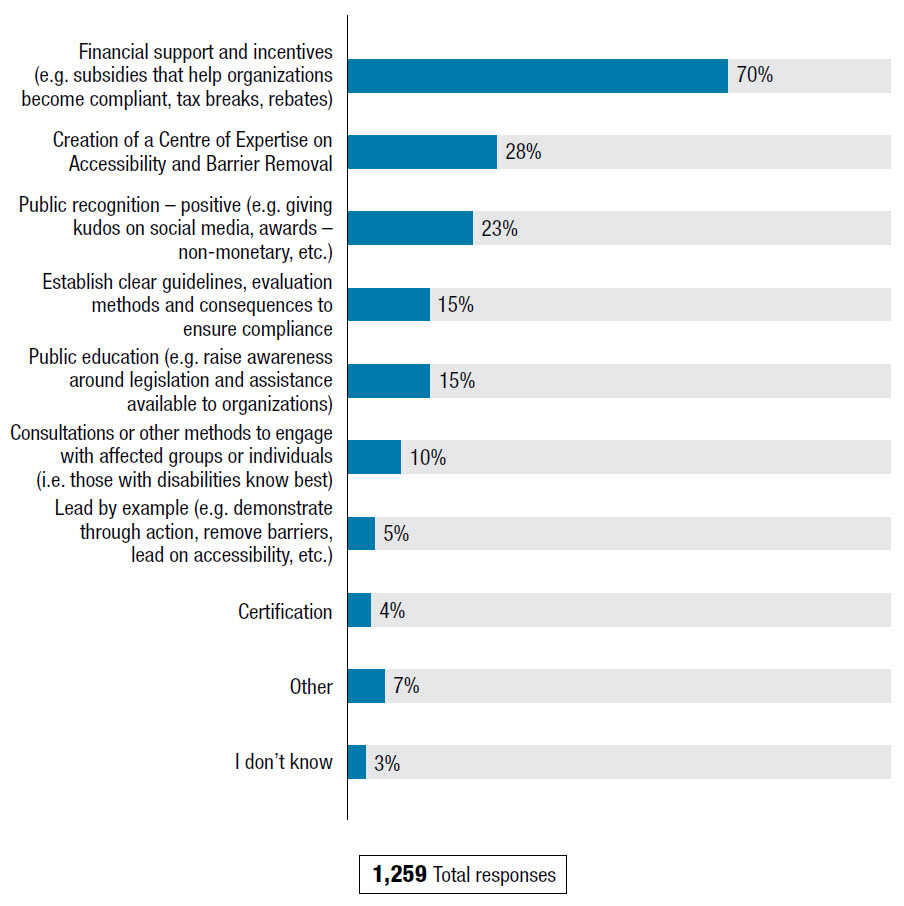
Graph 7 shows the results to the question: “Do you have suggestions for how the Government could help organizations to improve accessibility and remove barriers?”
- Seventy percent said financial support and incentives (for example, subsidies that help organizations become compliant, tax breaks, rebates), followed by the creation of a centre of expertise on accessibility and barrier removal (28%), public recognition – positive (for example, giving kudos on social media, awards, non-monetary, etc.) (23%), establish clear guidelines, evaluation methods and consequences to ensure compliance (15%), public education (for example, raise awareness around legislation and assistance available to organizations), consultations or other methods to engage with affected groups or individuals (for example, those with disabilities know best) (10%) and lead by example (for example, demonstrate through action, remove barriers, lead on accessibility, etc.) (5%).
- Four percent said certification, 7% responded other and 3% responded I don’t know.
- 1,259 people responded to this question.
Conclusion
The time to create new legislation to improve accessibility for all Canadians with disabilities is now.
The Government of Canada is in a unique position to bring about real change to the lives of Canadians with disabilities. While new legislation alone cannot remove all barriers, there is recognition that complementary supports and programs will be necessary to create new opportunities of full citizenship and participation for persons with disabilities and to help change the way people think about accessibility.
Coming out of the consultations, there is emerging consensus about what the new legislation should look like and the role of the Government of Canada. The legislation should both develop detailed policies for organizations on how to improve accessibility, while also supporting them in removing all barriers for their employees and customers. The Government of Canada should be a leader, both in practice and in supporting organizations to be successful. The Government of Canada should also set ambitious goals with clear and measurable targets.
As covered in this report, we heard what Canadians want in the legislation. We heard the call for the Government of Canada to be a leader. We heard the desire for a principled approach and widespread systemic change. We heard the need for complementary programming and supports. We can get there, but it will take time, hard work and proper support.
We thank each and every person who contributed and shared their ideas and stories with us. The ideas and recommendations provided through this historic consultation process have laid the foundation for the legislation and have set us on the path to improve accessibility for all Canadians.
Together, we will make Canada more accessible!

